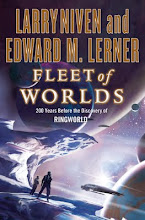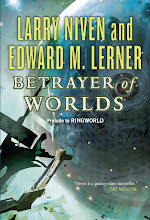 |
| Pink: most normal/visible mass. Blue: where most mass seems to be. |
Tuesday, August 29, 2017
Look! Up in the sky! Dark awesomeness.
My most recent post having been about the awesomeness of last week's total solar eclipse, why not post more generally about astronomy/cosmology news? Exciting things are happening in the broader (heh!) field -- as these four recent articles from Cosmos attest.
What we (think we) understand about the distribution of dark matter is inferred from observations of the motions of stars. A small fraction of stars move much faster than expected. So: what's that about? It's hard to know when so few stars are anomalous speed demons. If we had a bigger population to analyze, maybe we'd understand better. And -- leveraging a quite non-astronomical discipline -- perhaps soon we will. See "Artificial brain scans the galaxy for speeding stars: Neural networks come to astronomy as a self-adapting algorithm digs through star maps to find rogue fast-moving stars."
Wednesday, August 23, 2017
Awesome!
I'm newly home from Columbia, SC, where the wife and I went to see the solar eclipse. For both of us, this was our first total eclipse.
Wow, Just, wow.
The nearby photo isn't one I took. Plenty of photogs better than me are filling the web with eclipse imagery. I just wanted to take it all in. The excitement and expectancy of hundreds of people all around. The near-totality moment the crickets woke up. The pink sunset tinge looking west over Lake Murray, while the (mostly obscured) Sun remained high in the sky. Day become night. Baily's beads. The solar corona: way cool. The purple flash -- for which I have no name -- that appeared in the last instant of totality.
I'll be reliving this experience for awhile :-)
(Also the nightmarish drive home. I hope that fades from memory.)
Wow, Just, wow.
The nearby photo isn't one I took. Plenty of photogs better than me are filling the web with eclipse imagery. I just wanted to take it all in. The excitement and expectancy of hundreds of people all around. The near-totality moment the crickets woke up. The pink sunset tinge looking west over Lake Murray, while the (mostly obscured) Sun remained high in the sky. Day become night. Baily's beads. The solar corona: way cool. The purple flash -- for which I have no name -- that appeared in the last instant of totality.
I'll be reliving this experience for awhile :-)
(Also the nightmarish drive home. I hope that fades from memory.)
Monday, August 14, 2017
An olio portfolio
Notwithstanding -- and more likely related to -- my most recent post (Weird process, this writing), the writing has been progressing smoothly over the past week. Lots of deeper back story worked out and retrofit, where appropriate, into the novel presently under construction. Lots of new text added. (We won't, however, speak of the single paragraph in the original, high-level outline that has transmogrified in my latest plans into five future chapters. Those wounds are too fresh.)
Amid the progress, my willpower on occasion did slip, leaving me to lapse into some of my customary surfing. And so, herewith, I shall bring to your attention several eclectic -- and relevant -- observations of the sort visitors here seem to find of interest.
SF is about world-building, with "world" loosely defined. Something about an SFnal story setting(s), whether in time or place, dimension or natural law or the state of technology, is different. One peril of the process is describing a world that's too uniform (e.g., "the desert planet" or "the ocean planet"), because we tend to find those unbelievable. The single world any of us know is, after all, rich with plains, forests, deserts, mountains, oceans, glaciers .... And neither are natural resources uniformly distributed, available at the convenience of our characters. A recent real-world reminder of that inhomogeneity involves helium:
... the element is needed to use or make all sorts of things: semiconductors, rocket fuel, computer hard drives, the Large Hadron Collider, magnets in MRI machines, airships, scuba tanks, arc welding, anything that needs to be super cold, and of course, balloons.
See "How the Qatar Crisis Shook Up the World's Supply of Helium."
| A veritable cornucopia |
SF is about world-building, with "world" loosely defined. Something about an SFnal story setting(s), whether in time or place, dimension or natural law or the state of technology, is different. One peril of the process is describing a world that's too uniform (e.g., "the desert planet" or "the ocean planet"), because we tend to find those unbelievable. The single world any of us know is, after all, rich with plains, forests, deserts, mountains, oceans, glaciers .... And neither are natural resources uniformly distributed, available at the convenience of our characters. A recent real-world reminder of that inhomogeneity involves helium:
... the element is needed to use or make all sorts of things: semiconductors, rocket fuel, computer hard drives, the Large Hadron Collider, magnets in MRI machines, airships, scuba tanks, arc welding, anything that needs to be super cold, and of course, balloons.
See "How the Qatar Crisis Shook Up the World's Supply of Helium."
Monday, August 7, 2017
Weird process, this writing
A couple weeks back, I reported being in fast-and-furious writing mode. More recently, the work has continued fast and furious ... but I've been cranking away for more than a week without adding, or even changing, a word in the novel in progress. (The first draft is at about 70K words, so more than half complete. The book's working title is Déjà Doomed.)
For anything beyond a short story -- and often for those -- I write from an outline. After dozens of novels, novellas, and novelettes, I've learned a thing or two. One lesson is: don't make the initial outline too detailed, because late story elements developed early on will often require rework. Hence, my original, full-story outlines tend to be no longer than a handful of pages. Section by section, as I come to it, I develop a more detailed partial outline. Often I do an outline for each chapter within a section as I come to it. And almost always there is a need to iterate, as the details of Chapter X or Section Y ripple forward or backward through the overall story.
So there's another lesson: The outline(s) works for me, and for the story, not the other way around.
For anything beyond a short story -- and often for those -- I write from an outline. After dozens of novels, novellas, and novelettes, I've learned a thing or two. One lesson is: don't make the initial outline too detailed, because late story elements developed early on will often require rework. Hence, my original, full-story outlines tend to be no longer than a handful of pages. Section by section, as I come to it, I develop a more detailed partial outline. Often I do an outline for each chapter within a section as I come to it. And almost always there is a need to iterate, as the details of Chapter X or Section Y ripple forward or backward through the overall story.
So there's another lesson: The outline(s) works for me, and for the story, not the other way around.
Subscribe to:
Comments (Atom)


































